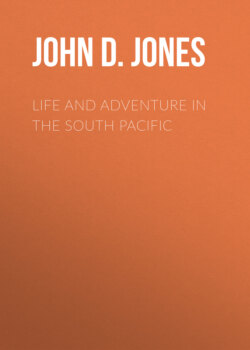Читать книгу Life and Adventure in the South Pacific - John D. Jones - Страница 13
На сайте Литреса книга снята с продажи.
CHAPTER X.
Cruising.—Boats’-crew Watches.—Deserters by wholesale.—A large Reward.—Public Auction.—Juan Fernandez.—Peaches.—Robinson Crusoe’s Cave.—Fishing.—Ship “Java.”—Masa Fuero.—St. Felix.—St. Ambrose.—San Lorenzo.—Callao.—A Railroad.
ОглавлениеTable of Contents
We were now fairly at sea again, cruising for whales. We were now, as is customary for whalemen alone while on cruising ground, standing “boats’-crew watches.” It will be recollected that in a former chapter we explained the “regular watches” of a ship’s company; but this is something entirely different. The ship’s company are now divided into three equal portions, and each watch has only “four hours out” each night and “eight hours in,” instead of four and eight hours alternately, as in the regular watches. They are regulated so as to alternate them every night, and are generally “headed” or in charge of the boat-steerers.
It was during one of these watches, on the morning of the 25th of March, that a boat-steerer and five foremast hands took the bow boat from off the cranes and deserted the ship. The boat-steerer who left was the one who headed the watch. It was blowing quite fresh from the southeast at the time, the ship standing to the westward under double-reefed topsails. The plot had probably been concocting for some days, as they took with them, in addition to most of their clothing, all the boat sails and a quantity of provisions and water, disabling the other boats by taking the “thole-pins” and hiding them. It was very rugged weather, and the experiment was dangerous, as the ship was going through the water about six knots. They succeeded, however, in getting clear.
JUAN FERNANDEZ, FROM THE SEA.
As soon as their absence was discovered, all hands were called, sail made, and we tacked ship and stood in for the land, which was about one hundred and eighty miles distant. At daybreak the captain offered a reward of one hundred dollars to the person who should first raise the boat from the masthead, but the reward was never claimed.
The man who was at the wheel at the time the boat was taken said he knew nothing about the boat going, although the boat-steerer came to the binnacle and took one of the ship’s compasses before his face. He said he thought the man wished to fix the compass. The captain was very much enraged, and could hardly keep his hands off the man.
After cruising a few days for the missing boat, and seeing nothing, we squared away for Juan Fernandez. The remark that “we see something new every day” is as applicable to whalers, and perhaps more so, as to any thing else. We now had something new, a public auction; the public, the ship’s company; the auctioneer, the captain; the “stock,” not Central Railroad, nor yet La Crosse and Milwaukie bonds, but the clothing and other valuables (!) left on board by deserters. This is the usual practice on board of whalemen, and we had several “public auctions” during the voyage.
On Tuesday, April 2d, 1850, we first sighted the island of Juan Fernandez, and the next day sent a boat on shore for peaches. Another boat and crew were dispatched fishing. This island looks beautiful from the sea, being very high land, and completely covered with verdure. Peaches and quinces grow here in great abundance. Wild goats are also found here in large numbers. There was but one family living on the island at this time, the head of which, we believe, was governor! We need hardly repeat here that this island is famous for having been the residence of Alexander Selkirk, a Scotch sailor, who was put ashore some years since, and remained a long time on the island, his adventures giving rise to the well-known story of Robinson Crusoe. The cave spoken of in that work as “Robinson Crusoe’s Cave” is still pointed out, whether the true one or not we are unable to say.
PEAK OF YONKA.
We now returned to the ship with our fish, etc., after having spent most of the day with poor success, and lost our boat-anchor. We found the other boat had arrived with peaches and quinces. We altered our course and steered north.
The next day we saw the island of Masa Fuero, very similar in its appearance to Juan; and on the 10th sighted the islands of St. Felix and St. Ambrose. They present a rocky, barren appearance, and are uninhabited except by sea-birds, who flock there in great numbers.
CRUSOE’S CAVE.
On the 17th we saw the island of San Lorenzo, off the town of Callao; and the next day we were “standing off and on” in the Bay of Callao, Peru. Our captain here went ashore to obtain medical advice and assistance for Mr. Lowe, our second officer, who has been for some time off duty, sick, his right side being affected with palsy.
This town is well laid out, the houses mostly one story. The streets are of good width and clean. This city was also destroyed in 1746 by an earthquake, and remains are yet to be seen as gloomy monuments placed over the ill-fated persons who were thus suddenly cut off. There is a railroad building from Callao to Lima, which is but seven miles distant. About 4 P.M. the captain and Mr. Lowe returned, and we filled away for Payta.
